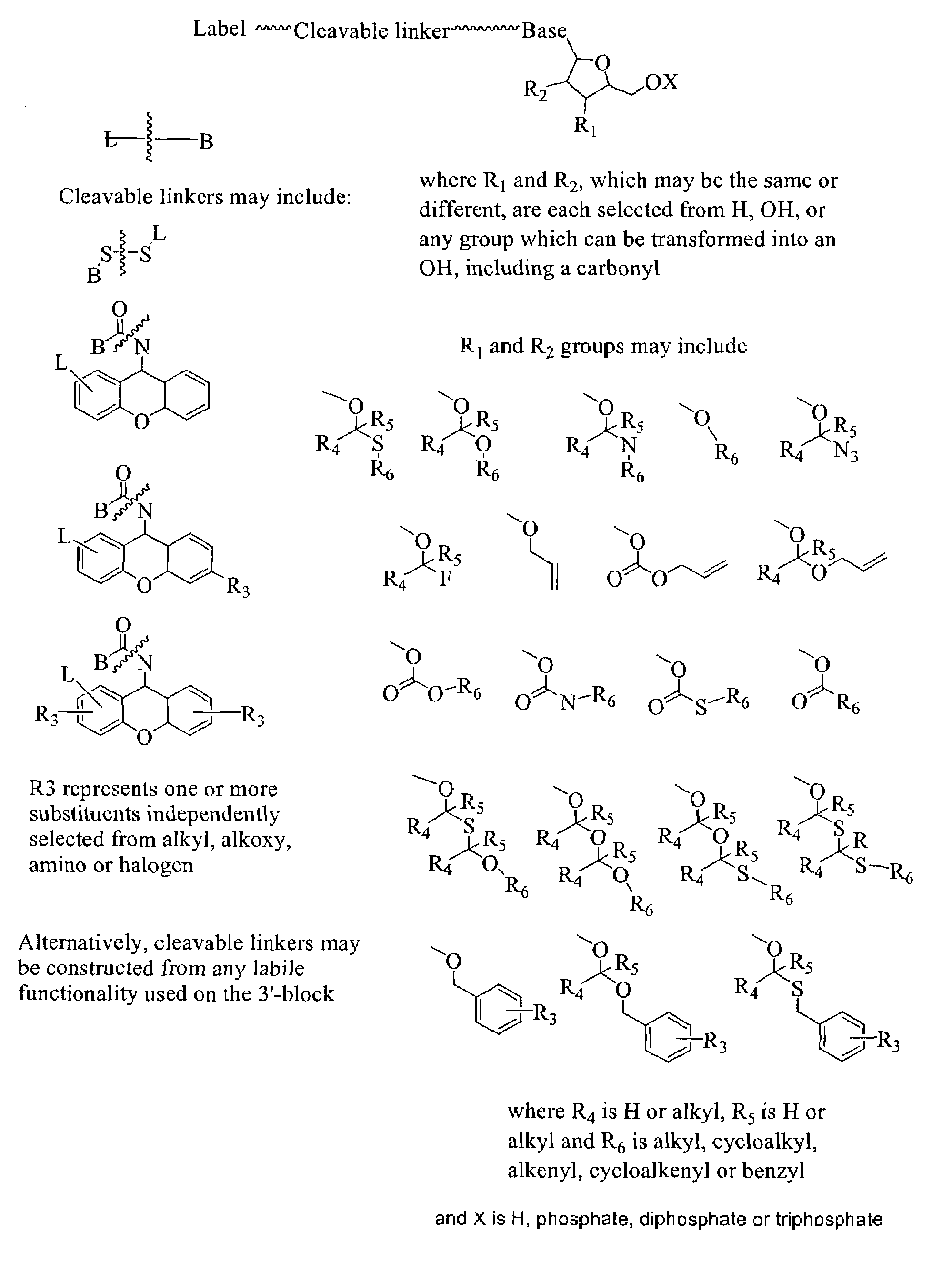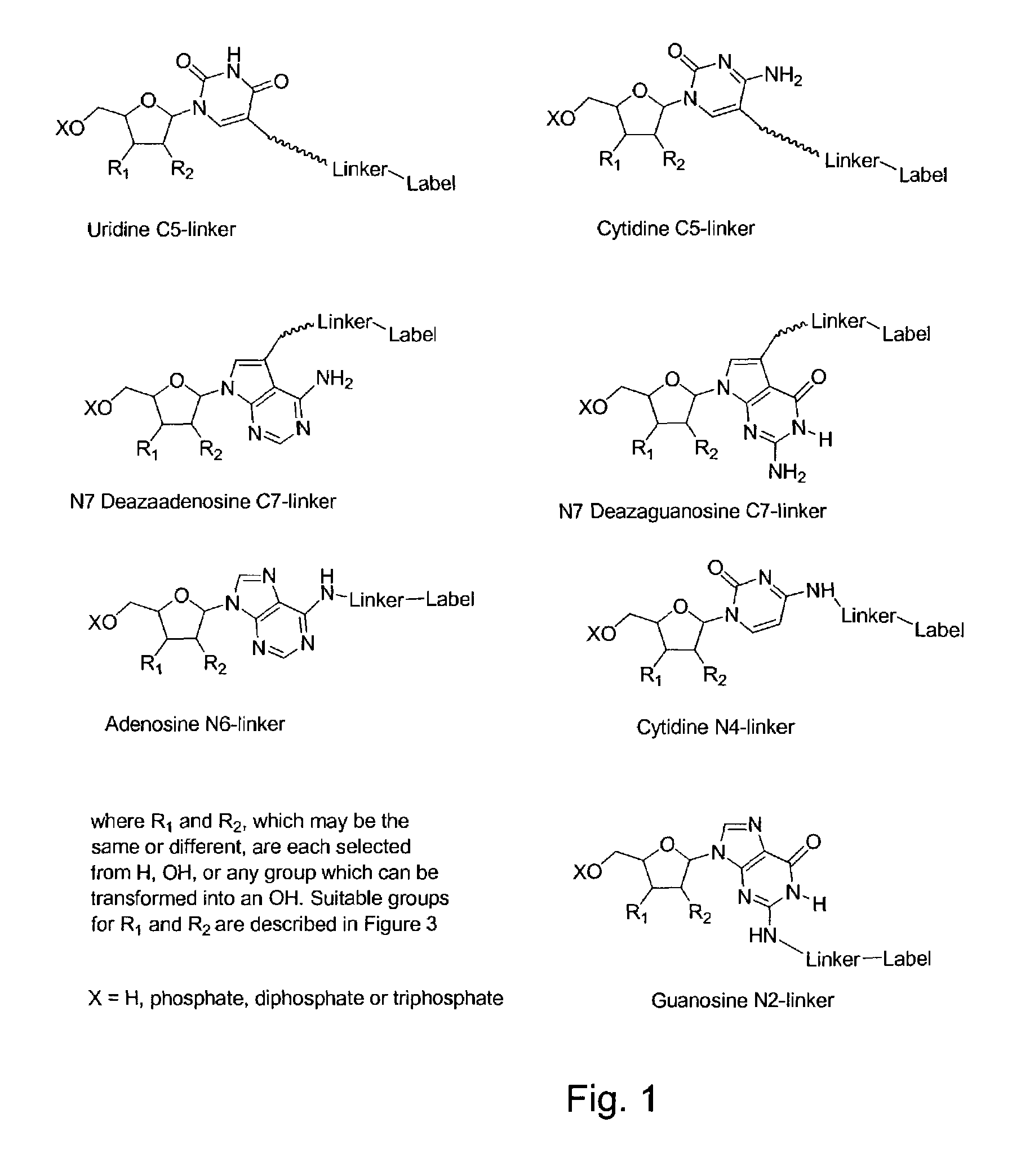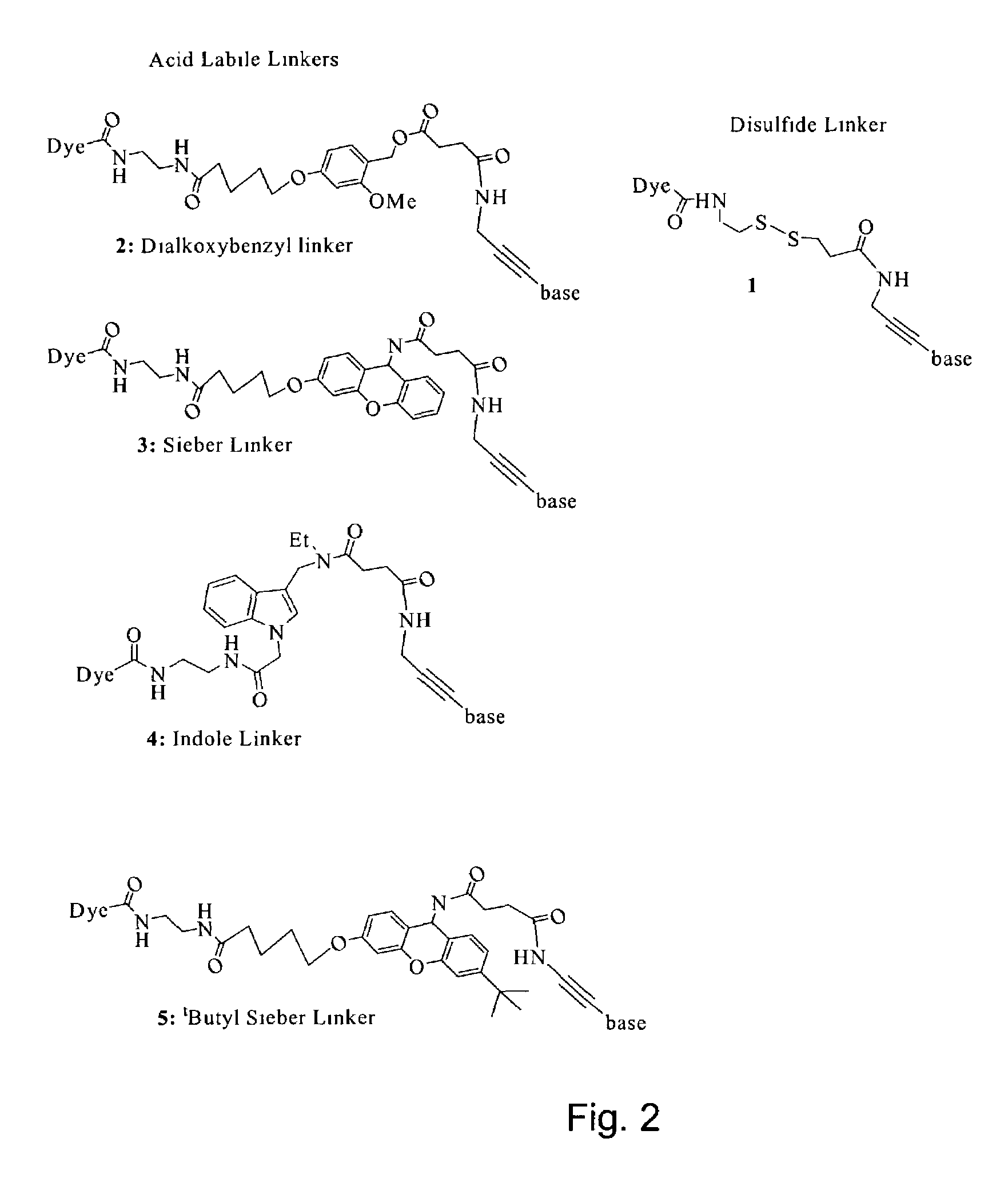Labelled nucleotides
a technology of labelled nucleotides and nucleotides, which is applied in the field of labelled nucleotides, can solve the problems that nucleotides are difficult to incorporate into existing polynucleotides,
- Summary
- Abstract
- Description
- Claims
- Application Information
AI Technical Summary
Benefits of technology
Problems solved by technology
Method used
Image
Examples
example 1
Synthesis of Disulfide Linker
[0087]
[0088]tButyl-N-(2-mercaptoethyl) carbamate (3 mmol, 0.5 mL) was added dropwise to a solution of 1.32 g (6.0 mmol) aldrithiol in 15 mL MeOH. After 1.5 h the reaction had gone to completion and the solvent was evaporated. The crude product was purified by chromatography on silica with ethyl acetate:petroleum ether (1:4). Product 1a was obtained as a slightly yellow oil (0.76 g, 2.67 mmol, 89%). 1H NMR (500 Mhz, D6-DMSO): δ=1.38 (s, 9 H, tBu), 2.88 (t, J=6.6 Hz, 2 H, SCH2)3.20(q, J=6.6 Hz, 2 H, CH2NH), 7.02 (bs, 1 H, NH), 7.24 (ddd, J=7.3 Hz, J=4.9 Hz, J=1.0 Hz, 1 H, H-5), 7.77 (dt, J=8.1 Hz, J=1.0 Hz, 1 H, H-3), 7.82 (ddd, J=8.1 Hz, J=7.4 Hz, J=1.8 Hz, 1 H, H-4), 8.46 (ddd, J=4.9 Hz, J=1.8 Hz, J=1.0 Hz, 1 H, H-6).
[0089]
[0090]To deprotect the amine of 1a, 17 mg of 1a (60 μmol) was dissolved in a mixture of 0.5 mL DCM and 0.5 mL trifluoracetic acid. This mixture was stirred for 2.5 h at rt and then the solvents were removed under reduced pressure. The ...
example 2
Synthesis of TMR-Sieber Linker Free Acid
[0097]
[0098]5-[-9-[9-(fluorenyl-methyloxycarbonyl)amino]xanthen-3-yl]valeric acid, (42.8 mg, 80 μmol) was stirred at room temperature with disuccinimidyl carbonate (22.5 mg, 88 μmol) and N,N-dimethyl aminopyridine (10.8 mg, 88 μmol) in DMF. After 5 minutes, mono-5-carboxy TMR ethylene diamine (198.9 mg, 40 μmol) was added followed by DIPEA (13.9 μl, 80 μmol). The reaction was stirred at room temperature. After 2 hrs, the reaction mixture was diluted with dichloromethane (100 mL) and the resulting solution was extracted with 1 M aqueous potassium dihydrogen phosphate (50 mL). The DCM layer was separated and evaporated under reduced pressure. The residue was purified by a short column chromatography. The fractions eluting with 40% methanol in chloroform were collected and evaporated under reduced pressure. The residue was then dissolved in dry DMF (1 mL) and N-(2-mercaptoethyl)aminomethyl polystyrene (200 mg, 400 μmol) and DBU (12 μl, 80 μmol). ...
example 3
Synthesis of TMR-Sieber Linker-dUTP (3)
[0099]
[0100]TMR-sieber linker free acid (4.34 mg, 5 μmol) was stirred with disuccinimidyl carbonate (1.74 mg, 7.5 μmol) and N,N-dimethyl aminopyridine (0.92 mg, 7.5 μmol) in DMF (1 mL) at room temperature. After 10 minutes, all the reaction mixture was added to tetra-(tri-butylammonium) salt of 5-(3-aminopropynyl)-2′-deoxyuridine-5′-triphosphate (10 μmol). The reaction was stirred at room temperature for 4 hrs and stored in the fridge overnight. The reaction mixture was then diluted with chilled water (10 mL) and all the resulting solution was applied onto a short column of DEAE A-25. The column was initially eluted with 0.1 M TEAB buffer and then 0.7 M TEAB buffer. The 0.7 M TEAB eluents were collected and evaporated under reduced pressure. The residue was co-evaporated with MeOH (2×10 mL) and then purified by preparative HPLC. The title compound was obtained as triethylammonium salt in 31% yield (based on the quantification of TMR at 555 nm i...
PUM
| Property | Measurement | Unit |
|---|---|---|
| diameter | aaaaa | aaaaa |
| distance | aaaaa | aaaaa |
| distance | aaaaa | aaaaa |
Abstract
Description
Claims
Application Information
 Login to View More
Login to View More - R&D
- Intellectual Property
- Life Sciences
- Materials
- Tech Scout
- Unparalleled Data Quality
- Higher Quality Content
- 60% Fewer Hallucinations
Browse by: Latest US Patents, China's latest patents, Technical Efficacy Thesaurus, Application Domain, Technology Topic, Popular Technical Reports.
© 2025 PatSnap. All rights reserved.Legal|Privacy policy|Modern Slavery Act Transparency Statement|Sitemap|About US| Contact US: help@patsnap.com



